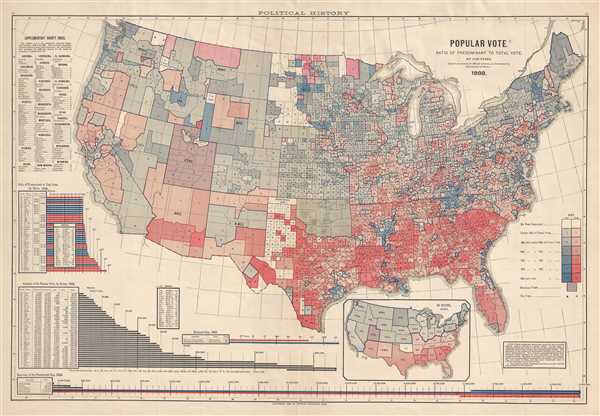This item has been sold, but you can get on the Waitlist to be notified if another example becomes available, or purchase a digital scan.
1889 Scribner's Voting Map of the United States
PopularVote1888-hewes-1889$137.50

Title
Popular Vote. Ratio of Predominant to Total Vote, by Counties.
1889 (dated) 17 x 25 in (43.18 x 63.5 cm) 1 : 8557000
1889 (dated) 17 x 25 in (43.18 x 63.5 cm) 1 : 8557000
Description
This is a Fletcher W. Hewes and Charles Scribner's Sons political map of the United States. The map depicts the continental United States from the Pacific Ocean to the Atlantic Ocean and from the Canadian border to the border with Mexico. Illustrating the results of the election of 1888 between Benjamin Harrison and Grover Cleveland by county, each state is divided into counties, which are numbered. The counties are then colored with different shades of red (for Democratic majorities) and blue (for Republican majorities). The counties shaded white, which include a fair number in Northwest Texas, and the western half of the Dakotas, did not report a vote. Oklahoma at this point in history, was the Indian Territory, so the Native Americans living there were not allowed to cast votes in the election of 1888, as they were not considered citizens. The Indian Citizenship Act was not passed by Congress until 1924. In the counties that reported vote totals, the darker the shade of red or blue, the greater the majority. The lightest shades represent majorities under 50% of the total vote, whereas the darkest shades represent majorities totaling over 90% of the total vote. The divide between Republicans and Democrats is clearly entrenched, with a deeply Democratic South and a majority of northern states voting Republican. It is important to note here that the Democratic and Republican Parties did not hold the same viewpoints and philosophies that they do today. These two parties have changed over time. A key explaining the shading on the map is situated along the right border, with a note stating that the blue color in Utah represents the Mormon vote.
Below the central map, a smaller inset map of the United States displays the popular vote by state. Each state is shaded in the same way that the counties are shaded on the larger, central map. The election of 1888 is one of five elections in which the candidate that won the presidency (Harrison) by winning the Electoral College vote, did not win the popular vote (Cleveland). A graph to the left of the inset map, illustrates the Electoral Vote, and Harrison's victory. More tables, located in the lower left corner of the map, further break down the election results, analyzing the popular vote and the ratio of the predominant to total vote by state, among other statistics.
This map was produced by Fletcher W. Hewes for inclusion in the Citizen's Atlas of American Politics 1789-1892 and copyrighted by Charles Scribner's Sons in 1893.
Below the central map, a smaller inset map of the United States displays the popular vote by state. Each state is shaded in the same way that the counties are shaded on the larger, central map. The election of 1888 is one of five elections in which the candidate that won the presidency (Harrison) by winning the Electoral College vote, did not win the popular vote (Cleveland). A graph to the left of the inset map, illustrates the Electoral Vote, and Harrison's victory. More tables, located in the lower left corner of the map, further break down the election results, analyzing the popular vote and the ratio of the predominant to total vote by state, among other statistics.
This map was produced by Fletcher W. Hewes for inclusion in the Citizen's Atlas of American Politics 1789-1892 and copyrighted by Charles Scribner's Sons in 1893.
Source
Hewes, F. W., Citizen's Atlas of American Politics. 1789-1892., (New York: Charles Scribner's Sons) 1892.
Condition
Very good. Light wear along original centerfold. Blank on verso.

